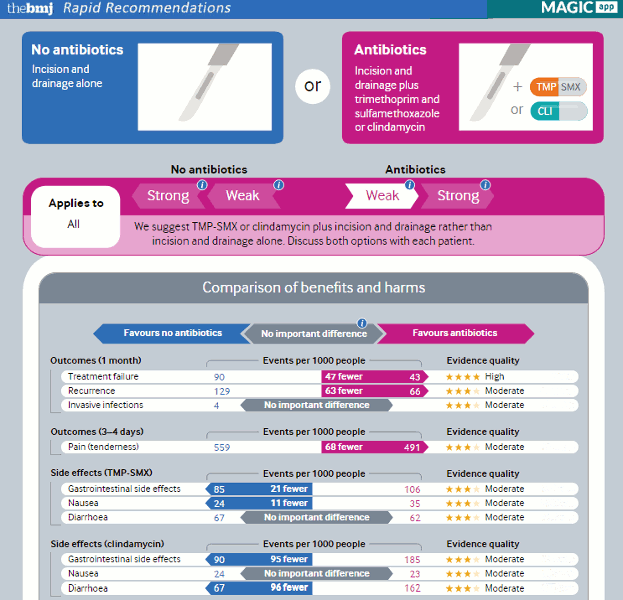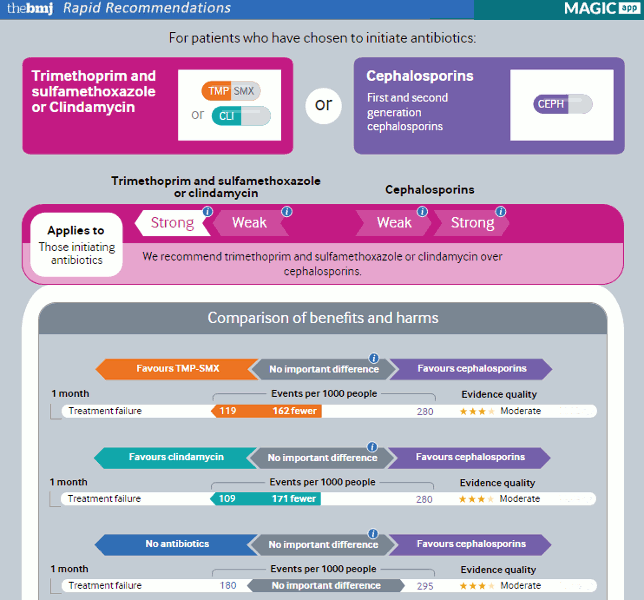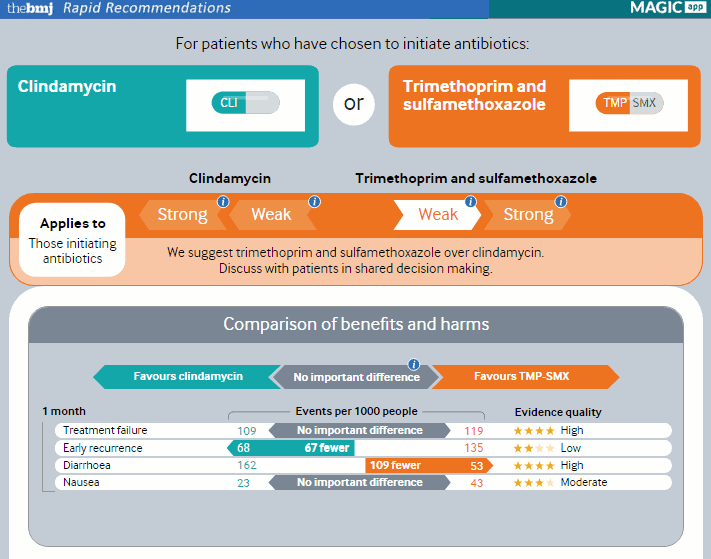Approach
Community-associated MRSA skin and soft-tissue infections (SSTIs) can usually be treated in the outpatient setting with oral antibiotics. Abscesses should be drained. Close follow-up is necessary to confirm improvement. More severe infections may require hospitalisation.
Complicated infections, such as endocarditis, joint infections, pneumonia, and bacteraemia, require hospitalisation and intravenous antibiotics. Concurrent abscess incision and drainage is a critical part of management, which may be curative.[30][31][32][33]
Whenever possible, appropriate cultures should be sent for identification and susceptibilities before antibiotics are commenced.
Skin and soft-tissue infections
Community-associated SSTIs: uncomplicated
Incision and drainage alone (without antibiotics) may be sufficient treatment for small abscesses (e.g., <5 cm for skin and soft tissue). Concomitant antibiotic therapy may be recommended for patients who are immunocompromised, at extremes of age, or have associated comorbidities or an abscess in an area difficult to drain.[30][31][32][34] However, emerging evidence suggests that all patients with uncomplicated skin abscess may benefit from trimethoprim/sulfamethoxazole or clindamycin in addition to incision and drainage, rather than incision and drainage alone. The benefit of antibiotics in this setting should be considered against side effects for the patient and risk of antimicrobial resistance in the community, and shared decision-making is important.
BMJ Rapid Recommendations: antibiotics after incision and drainage for uncomplicated skin abscesses Opens in new window[Figure caption and citation for the preceding image starts]: BMJ Rapid Recommendations: Antibiotics after incision and drainage for uncomplicated skin abscessesBMJ 2018;360:k243 [Citation ends].
 [Figure caption and citation for the preceding image starts]: BMJ Rapid Recommendations: Antibiotics after incision and drainage for uncomplicated skin abscessesBMJ 2018;360:k243 [Citation ends].
[Figure caption and citation for the preceding image starts]: BMJ Rapid Recommendations: Antibiotics after incision and drainage for uncomplicated skin abscessesBMJ 2018;360:k243 [Citation ends]. [Figure caption and citation for the preceding image starts]: BMJ Rapid Recommendations: antibiotics after incision and drainage for uncomplicated skin abscessesBMJ 2018;360:k243 [Citation ends].
[Figure caption and citation for the preceding image starts]: BMJ Rapid Recommendations: antibiotics after incision and drainage for uncomplicated skin abscessesBMJ 2018;360:k243 [Citation ends]. MAGICapp: recommendations, evidence summaries and consultation decision aids
Opens in new window
MAGICapp: recommendations, evidence summaries and consultation decision aids
Opens in new windowMost community-associated MRSA is sensitive to oral antibiotics. Oral antibiotics (such as trimethoprim/sulfamethoxazole, minocycline, doxycycline, or clindamycin) are used in the treatment of uncomplicated SSTIs, when the patient has no evidence of systemic infection (e.g., abscess or presumed infected spider bite). Choice of which oral antibiotic to use depends on the local antibiogram. Some experts suggest avoiding clindamycin when local resistance rates for MRSA isolates causing skin infection are greater than 10% to 15%.[35]
Linezolid, tedizolid, omadacycline, and delafloxacin are alternative options. The cost and availability of these alternatives may be limiting and they should only be used in consultation with an infectious disease specialist.
Fluoroquinolones such as delafloxacin are associated with serious, disabling, and potentially irreversible adverse effects including tendonitis, tendon rupture, arthralgia, neuropathies, and other musculoskeletal or nervous system effects.[36][37] The US Food and Drug Administration (FDA) has also issued warnings about the increased risk of aortic dissection, significant hypoglycaemia, and mental health adverse effects in patients taking fluoroquinolones.[38][39]
Lack of response to oral antibiotics is an indication for hospitalisation and intravenous antibiotics.
Community-associated SSTIs: complicated
Complicated infection (evidence of systemic infection) is an indication for hospitalisation and intravenous antibiotics. A complicated infection is one where there are signs and symptoms of systemic involvement: for example, hypotension, tachycardia, renal failure, pulmonary compromise, evidence of shock and delirium.
Debridement or incision and drainage should be undertaken if clinically necessary. If the diagnosis is not yet confirmed, debrided material should be sent for culture and susceptibility testing.
Vancomycin or teicoplanin (where available) is recommended as first-line therapy for patients with complicated SSTIs.[40] Serum levels of vancomycin must be monitored throughout treatment. Alternative intravenous antibiotics include daptomycin, linezolid, tedizolid, tigecycline, telavancin, dalbavancin, oritavancin, ceftaroline, omadacycline, and delafloxacin. These alternatives should only be used in consultation with an infectious disease specialist.
Fluoroquinolones such as delafloxacin are associated with serious, disabling, and potentially irreversible adverse effects including tendonitis, tendon rupture, arthralgia, neuropathies, and other musculoskeletal or nervous system effects.[36][37] The FDA has also issued warnings about the increased risk of aortic dissection, significant hypoglycaemia, and mental health adverse effects in patients taking fluoroquinolones.[38][39]
Quinupristin/dalfopristin should only be considered as a salvage therapy due to limited data, potential resistance, drug-drug interactions, serious adverse effects, and cost.[41] Consultation with an infectious disease specialist is advisable.
Healthcare-associated SSTIs
These infections are more likely to require intravenous antibiotics.
Debridement or incision and drainage should be undertaken if clinically necessary. If the diagnosis is not yet confirmed, debrided material should be sent for culture and susceptibility testing.
First-line treatment is vancomycin or teicoplanin (where available). Serum vancomycin levels must be monitored throughout treatment. Alternative options include daptomycin, linezolid, tedizolid, tigecycline, telavancin, dalbavancin, oritavancin, ceftaroline, omadacycline, and delafloxacin.
Fluoroquinolones such as delafloxacin are associated with serious, disabling, and potentially irreversible adverse effects including tendonitis, tendon rupture, arthralgia, neuropathies, and other musculoskeletal or nervous system effects.[36][37] The FDA has also issued warnings about the increased risk of aortic dissection, significant hypoglycaemia, and mental health adverse effects in patients taking fluoroquinolones.[38][39]
Quinupristin/dalfopristin should only be considered as a salvage therapy due to limited data, potential resistance, drug-drug interactions, serious adverse effects, and cost.[41] Consultation with an infectious disease specialist is advisable.
Bacteraemia and sepsis
Bacteraemia is often accompanied by signs and symptoms of sepsis. Sepsis is defined as life-threatening organ dysfunction caused by a dysregulated host response to an infection.[23] Presentation of sepsis may range from non-specific or non-localised symptoms (e.g., feeling ill with a normal temperature), to severe signs with evidence of multiorgan dysfunction and septic shock. The threshold for clinical suspicion should be low. See Sepsis in adults.
Intravenous antibiotics are usually advised for MRSA bacteraemia.[42][43] Vancomycin is generally recommended as first-line therapy. Linezolid, daptomycin, and teicoplanin (where available) are also used. Identification and removal of potential sources of infection, such as abscess or intravascular catheters, is prudent.
Pneumonia
Pneumonia due to MRSA should be treated with intravenous antibiotics. Vancomycin is generally recommended as first-line therapy.[40] In the UK, National Institute for Health and Care Excellence guidelines include teicoplanin as a first-line option for hospital-acquired pneumonia where MRSA is suspected.[44] One randomised controlled study suggested that linezolid might be more effective than vancomycin for the treatment of MRSA pneumonia, although 60-day mortality was similar for the vancomycin and linezolid groups.[45]
Visceral abscess
Abscesses may occur at any site. Incision and drainage is paramount in the treatment of an abscess of any site. Concomitant antibiotics are often given, with vancomycin recommended as first-line therapy.
Endocarditis
Generally, endocarditis is divided into native valve and prosthetic valve endocarditis. Intravenous antibiotics are recommended for a prolonged period of time. Vancomycin is generally recommended as first-line therapy for native valve endocarditis. Daptomycin may be used for native valve tricuspid valve endocarditis. Linezolid is not routinely recommended for endocarditis. If it is used, it should be under consultation with an infectious disease sub-specialist. Intravenous vancomycin and gentamicin plus oral rifampicin are used in combination for prosthetic valve endocarditis.
Surgery is indicated for heart failure, severe regurgitation, and haemodynamic instability, or for abscess or fistula formation in both types of endocarditis.[46]
Early involvement of a cardiovascular surgery specialist is prudent. Patients need to be stabilised before undergoing repair or replacement.
Septic arthritis
The septic joint should be aspirated, and intravenous antibiotics started. Some experts recommend combination therapy with the addition of oral rifampicin in native joint infection, and in single stage revision in prosthetic joint infection. Rifampicin should not be used alone because resistance may develop during therapy. Further changes in antibiotics depend on the results of culture sensitivities. Surgery may be needed for debridement. Prosthetic joints present specific challenges, including the possible need for joint removal and replacement. Orthopaedic surgery consultation is prudent.
Urinary tract infection
Removal of urinary catheters is recommended. Urinary tract infections (UTIs) may be treated with oral or intravenous antibiotics, depending on sensitivities and the severity of the illness. Uncomplicated UTIs may present with symptoms of dysuria and fever without evidence of sepsis, and can be treated with oral antibiotics. Patients with signs and symptoms of sepsis, or evidence on culture of resistant organisms, usually require intravenous antibiotics. Consider an evaluation for endovascular infection in patients who have a UTI caused by MRSA without a urinary catheter in place and without recent urinary tract instrumentation.
Osteomyelitis
Treatment includes culture-directed antibiotic therapy and superficial or surgical debridement. If immediate treatment is required before debridement and cultures, empiric broad-spectrum antibiotics may be initiated and the regimen modified when the results of cultures and sensitivity tests are known. If an empiric regimen has been initiated, it should be discontinued for 3 days before the collection of samples for cultures.
Prevention of spread
Good hand hygiene is the most important strategy to prevent spread of MRSA. Further potential strategies for infection control include:[47][48][49]
Active surveillance to identify MRSA carriers and subsequent isolation of MRSA carriers by cohorting or initiating contact precautions
Chlorhexidine bathing and possibly application of intranasal mupirocin to the nares.[50] [
 ]
]
Evidence shows significant impact of national infection control programmes that include these measures, on rates of infections including MRSA. A well documented example includes the UK, where MRSA declined across the UK National Health Service in the decade that followed implementation of a national infection control campaign. The campaign included measures targeting device-related healthcare-associated infections due to vascular and urinary catheters and intubation, in addition to general measures such as increasing hand hygiene compliance and hospital cleaning. There was a 97% reduction in intensive care unit-acquired MRSA bloodstream infections in patients between 2007 and 2016, and a 78% decrease in intensive care unit-acquired bloodstream infections overall.[9]
Use of this content is subject to our disclaimer